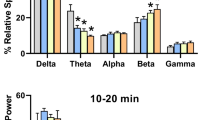Abstract
Rationale: It has been suggested that different BZ (ω) receptor subtypes may mediate distinct behavioural effects of BZ receptor ligands. Objective: The present study examined this hypothesis further. Methods: The antagonism exerted by the selective BZ1 (ω1) receptor antagonist β-CCT on the pharmacological effects of the selective BZ1 (ω1) receptor agonist zolpidem and the non-selective BZ (ω) receptor agonist diazepam in behavioural, biochemical and electrophysiological experiments was assessed. Results:β-CCT which was devoid of activity per se, antagonized the effects of the non-selective BZ (ω) receptor full agonist diazepam and the selective BZ1 (ω1) receptor full agonist zolpidem against seizures produced by isoniazid, but β-CCT failed to affect their action on seizures produced by pentylenetetrazole (PTZ), suggesting that BZ2 (ω2) receptors may be primarily involved in the convulsant action of PTZ. In the light/dark test, β-CCT abolished the anxiolytic-like action of diazepam. In tests designed to investigate the central depressant activity of drugs, β-CCT antagonized the sedative effects of diazepam and zolpidem, but failed to modify clearly the myorelaxant effects of diazepam. These differences may be related to the selectivity of β-CCT for BZ1 (ω1) sites as indicated by the preferential displacement of [3H]flumazenil in BZ1 (ω1)-enriched structures as compared to BZ2 (ω2)-enriched structures in the mouse. In in vitro experiments, β-CCT antagonized the potentiation of the GABA-induced Cl– current produced by zolpidem in HEK cells expressing the α1β2γ2 receptor or in cerebellar Purkinje neurones, while it failed to modify the diazepam potentiation at either α3β2γ2 or α5β3γ2 receptor subtypes. Conclusion: These results are consistent with the hypothesis that BZ1 (ω1) receptors play an important role in the anxiolytic and sedative/hypnotic effects of BZ (ω) receptor ligands, whereas activity at BZ2 (ω2) sites might be associated primarily with muscle relaxation.
Similar content being viewed by others
Author information
Authors and Affiliations
Additional information
Received: 14 February 1999 / Final version: 20 April 1999
Rights and permissions
About this article
Cite this article
Griebel, G., Perrault, G., Letang, V. et al. New evidence that the pharmacological effects of benzodiazepine receptor ligands can be associated with activities at different BZ (ω) receptor subtypes. Psychopharmacology 146, 205–213 (1999). https://doi.org/10.1007/s002130051108
Issue Date:
DOI: https://doi.org/10.1007/s002130051108




